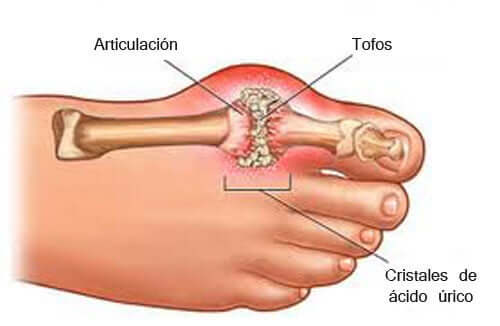Gout Diet: Recommendations and Prohibitions


Written and verified by the nutritionist Eliana Delgado Villanueva
A gout diet can help reduce blood uric acid levels. But it can’t cure the disease. However, it can reduce the risk of recurring and painful gout attacks and may reduce the progression of joint damage.
People who suffer from this disease and follow a gout diet also need to take drugs to control their pain and reduce uric acid levels. In this article, we’ll show you the dietary recommendations and prohibitions to improve this condition.
What’s gout?

This is one of the most common metabolic disorders and a painful form of arthritis. It’s caused by an increase in uric acid in the blood, which is known as hyperuricemia.
It doesn’t usually cause previous symptoms, although it can become deposited in the joints, leading to really painful inflammation that can be accompanied by fever.
The body produces uric acid when it breaks down chemicals called purines. Although purines occur naturally in the body, some foods are rich in them. The body excretes uric acid through the urine.
To avoid gout attacks, or at least slow down joint damage, you can resort to certain foods as a method of reducing high uric acid levels.
You should also read: Do You Suffer from Gout? Avoid These 7 Foods
Factors to consider in a gout diet

A specific diet to reduce blood uric acid levels has to focus on controlling three main factors:
1. Urine pH. It’s important to try to follow a basifying or alkalizing diet to slightly change the urine’s pH and promote elimination. You can achieve this mainly by:
- Consuming more basifying foods, such as vegetables, potatoes, fruit, sweet potatoes, and salads.
- Avoiding the consumption of foods rich in salt as well as adding it to homemade culinary preparations.
- Completely avoiding alcohol consumption, including beer and wine.
2. Purine ingestion. You need to pay close attention to the foods you eat and how you prepare them. When you boil a food that contains purines, a large part of them pass into the cooking water. Therefore, boiling is a good way to reduce purines in food. Nevertheless, you need to avoid broths.
3. The intake of fructose. Once the body assimilates fructose, it metabolizes it into xanthine, a purine that eventually passes into uric acid. For this reason, experts recommend that people who suffer from this condition only consume one piece of fruit a day and choosing the fruits that contain the least amount of fructose.
Allowed foods
- Proteins. Mainly consume red meat and lean poultry, low-fat dairy products, and lentils as protein sources.
- Complex carbohydrates. Eat more vegetables and whole grains, which contain complex carbohydrates.
- Vitamin C. Some studies show that this vitamin can help lower uric acid levels. Ask your doctor if you should incorporate a 500-milligram vitamin C supplement into your diet.
- Coffee. Some studies suggest that moderate coffee consumption may be associated with a lower risk of gout. Drinking coffee may not be appropriate if you suffer from other medical conditions. Ask your doctor how much coffee you can consume.
- Cherries. There’s evidence that eating cherries is associated with a lower risk of gout attacks.
This article may interest you: Gout: 8 Foods that Can Cause It
Forbidden foods

- Organ and glandular meats. Avoid meats such as liver, kidney, and sweetbreads, which contain a significant amount of purines and contribute to increased blood uric acid levels.
- Red meat. Limit the portion sizes of beef, lamb, and pork.
- Seafood. Some types of seafood and fish (such as anchovies, crustaceans, sardines, and tuna) contain more purines than others. However, the overall health benefits of eating fish may outweigh the risks for people with gout.
- Vegetables that contain a lot of purines. Various studies have shown that vegetables high in purines, such as asparagus and spinach, don’t increase the risk of gout and recurrent gout attacks.
- Alcoholic beverages. The consumption of beer and distilled spirits is associated with an increased risk of gout and recurrent attacks. Moderate wine consumption doesn’t seem to increase the risk of gout attacks. Avoid drinking alcoholic beverages during gout attacks and especially limit your consumption of beer.
- Sugary foods and drinks. Limit or avoid sugary foods, such as sweetened cereals, baked products, and candy. Limit your intake of naturally sweet fruit juices.
In conclusion
Following a gout diet can help limit uric acid production and boost its elimination. While it may not be enough to follow a diet to lower blood uric acid levels without drugs, dieting can help decrease the number of attacks and moderate their severity.
https://mejorconsalud.as.com/dieta-gota-recomendaciones-prohibiciones
All cited sources were thoroughly reviewed by our team to ensure their quality, reliability, currency, and validity. The bibliography of this article was considered reliable and of academic or scientific accuracy.
- Li R., Yu K., Li C., Dietary factors and risk of gout and hyperuricemia: a meta analysis and systematic review. Asia Pac J Clin Nutr, 2018. 27 (6): 1344-1356.
- Choi HK., Gao X., Curhan G., Vitamin C intake and the risk of gout in men: a prospective study. Arch Intern Med, 2009. 169 (5): 502-7.
- Choi HK., Curhan G., Coffee, tea, and caffeine consumption and serum uric acid level: the third national health and nutrition examination survey. Arthritis Care & Research, 2007.
This text is provided for informational purposes only and does not replace consultation with a professional. If in doubt, consult your specialist.








